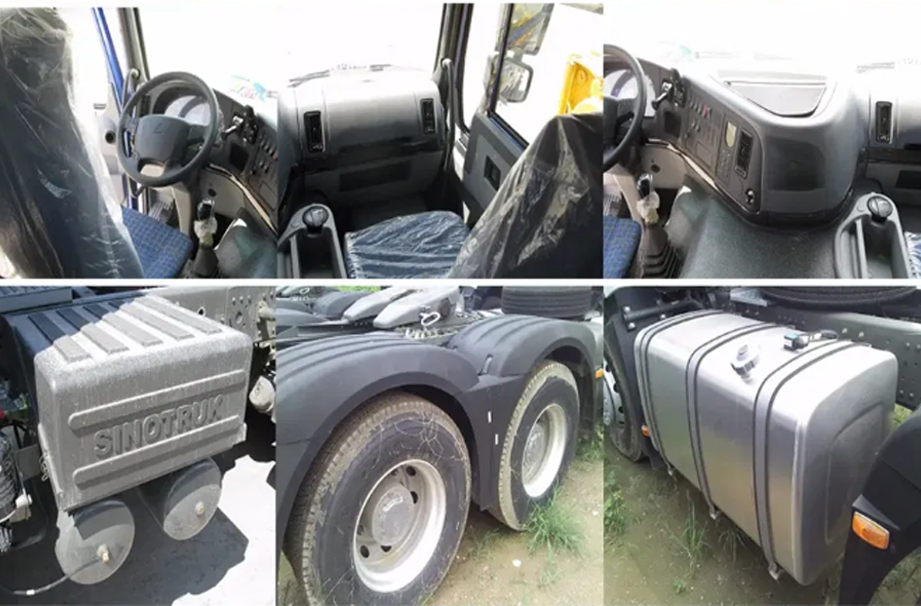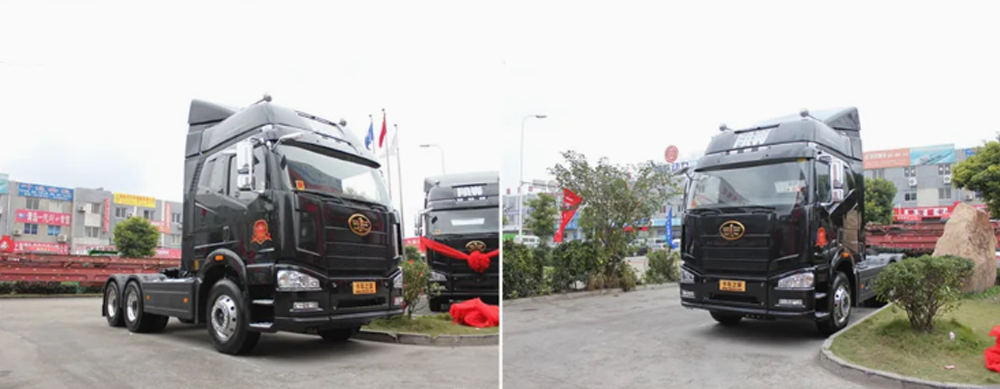A tractor head is a crucial and powerful piece of machinery in the agricultural and transportation sectors. Built with a robust steel frame, it showcases excellent durability to withstand heavy workloads and rough terrains. It's equipped with a high-performance diesel engine, generating substantial horsepower and torque, which enables it to tow hefty trailers or agricultural implements with ease.
The operator's cabin is designed for comfort and functionality. It features ergonomic seating, intuitive control panels, and excellent visibility, ensuring a smooth driving experience even during long hours of operation. With advanced transmission systems, like manual or automatic options, operators can adjust gears precisely to match different tasks.
| Drive form: | 6X4 | 6X4 | 6X4 | 4X2 | 4X2 | 4X2 |
| Wheelbase: | 3800+1400mm | 3200+1400mm | 3800+1400mm | 3600mm | 3600mm | 3600mm |
| Rear axle speed ratio: | 3.7 | 3.08 | 4.11 | 4.11 | ||
| Maximum speed: | 89km/h | 89km/h | 110km/h | 110km/h | 89km/h | 110km/h |
| Fuel type: | LNG | Diesel | Diesel | Diesel | Diesel | Diesel |
| Displacement: | 12.54L | 10.5L | 12.419L | 9.5L | 7.8L | 6.87L |
| Emission standards: | Euro 5 | Euro 5 | Euro 5 | Euro 5 | Euro 5 | Euro 5 |
| Maximum Horsepower: | 480hp | 460hp | 44hp | 400hp | 350hp | 330hp |
| Maximum output power: | 353kW | 338kW | 327kW | 294kW | 257kW | 237kW |
| Maximum torque: | 2300N·m | 2100N·m | 2100N·m | 1900N·m | 1400N·m | 1238N·m |
| Maximum torque speed: | 800-1300rpm | 1000-1400rpm | 1000-1400rpm | 1200-1300rpm | 1200-1600rpm | 1200-1800rpm |
| Gear shift method: | Manual | Manual | Manual | Manual | Manual | Manual |
| Forward gear: | 12-speed | 12-speed | 12-speed | 12-speed | 8-speed | 10-speed |
| Reverse gears | 2 | 2 | 2 | 2 | 2 | 2 |
| Fuel tank capacity: | 1350L | 400L | 400L | 400L | ||
| Cab | (Single bed, A/C) , Four-point air suspension+Shock absorber+Horizontal stabilizer, Split type single bed, With air suspension seat, Adjustable steering wheel | |||||
| Air conditioning heater, VDO instrument, Electrical apparatus control system, Double locking structure belts, Electric lift glass and rearview mirror, Sun shade outside, The dome+The side inlet cover, Electronic hand throttle | ||||||

1. The chassis is the backbone of a tractor head. It's typically a heavy-duty steel frame that provides structural integrity and support for all other components.
2. The engine is the heart of the tractor head. Tractor engines are usually diesel-powered due to their high torque output, which is essential for heavy-duty work. The engine's power output can vary widely depending on the tractor's intended use. It ranges from relatively small engines for light-duty tasks to large, high-horsepower engines for heavy agricultural or industrial applications.
3. The transmission system in a tractor head is responsible for transferring power from the engine to the wheels or other driven components. There are different types of transmissions, including manual, semi-automatic, and fully-automatic.
4. The operator's cabin is designed to provide a comfortable and safe working environment. It's usually equipped with an ergonomic seat that can be adjusted to suit different operators.
5. Tractor heads have heavy-duty axles that are designed to support the weight of the tractor and any attached implements or loads.
6. The hydraulic system is a vital component of a tractor head. It's used to power various implements and attachments, such as loaders, plows, and harvesters.

1. Horsepower and Torque: Consider the tasks you'll be using the tractor head for. If you're mainly doing light-duty work like mowing small lawns or operating small implements, a tractor with lower horsepower (around 20-50 HP) might be sufficient.
2. Transmission Type: There are different transmission options. Manual transmissions give you more control over gear selection and are often preferred for experienced operators who need to fine-tune the tractor's speed and power output for specific tasks.
3. Width and Track Width: The width of the tractor head should be suitable for the areas where you'll be operating.
4. Height and Clearance: Consider the height of the tractor, especially if you need to operate under low-hanging branches or in buildings with height restrictions.
5. Operator's Cabin: Look for a well-designed cabin that offers a comfortable seating position with good lumbar support.
6. Control Layout: The controls inside the cabin should be intuitive and easy to reach. The placement of the steering wheel, gearshift lever, throttle, and other important controls should be designed with the operator's ease of use in mind.
7. Hydraulic Capacity: A powerful hydraulic system is essential if you plan to use a variety of hydraulic-powered implements such as loaders, backhoes, or three-point hitch attachments.

Tractor heads are equipped with robust engines, usually diesel-powered. These engines are designed to generate high torque, which is essential for heavy-duty tasks. The power output can range from a few dozen to several hundred horsepower, depending on the tractor's intended use.
They have a versatile transmission system that allows for different speed and power settings. Manual transmissions give the operator precise control over gear selection, enabling them to adjust the tractor's speed and torque according to the specific requirements of the task.
The three-point hitch is a key feature of tractor heads. It provides a standardized and efficient way to attach a wide variety of implements such as plows, harrows, and cultivators.
The PTO is another important component. It allows the tractor head to transfer power from the engine to other machinery or implements.
The operator's cabin in a tractor head is designed with comfort and functionality in mind. It offers a comfortable seat with adjustable features to reduce operator fatigue during long hours of work.
A powerful hydraulic system is a characteristic feature. It is used to power various functions such as lifting and lowering the three - point hitch, operating loaders, and other hydraulic-powered attachments.
